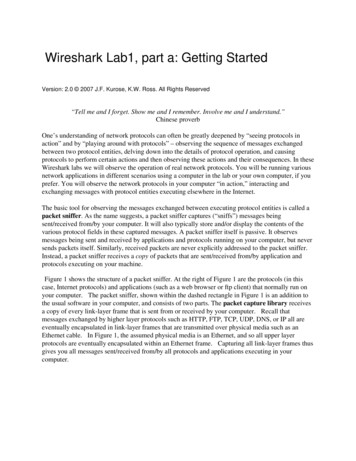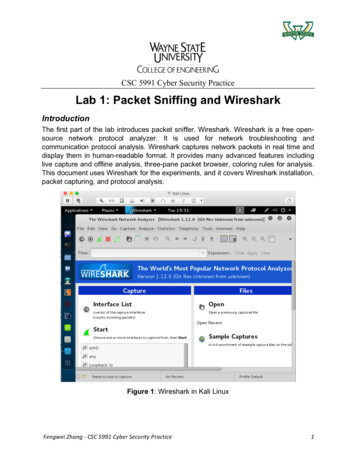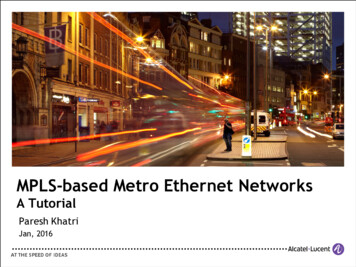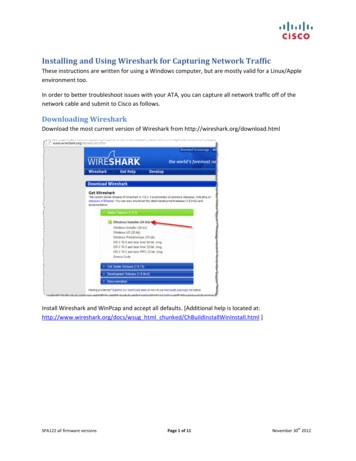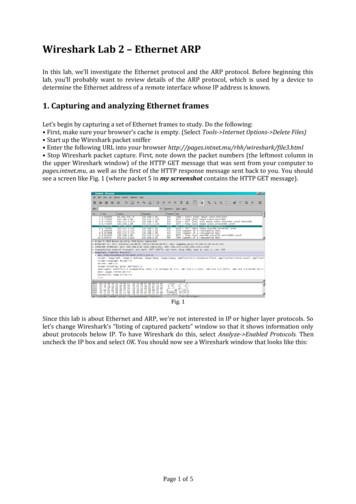
Transcription
Wireshark Lab 2 – Ethernet ARPIn this lab, we’ll investigate the Ethernet protocol and the ARP protocol. Before beginning thislab, you’ll probably want to review details of the ARP protocol, which is used by a device todetermine the Ethernet address of a remote interface whose IP address is known.1. Capturing and analyzing Ethernet framesLet’s begin by capturing a set of Ethernet frames to study. Do the following: First, make sure your browser’s cache is empty. (Select Tools- Internet Options- Delete Files) Start up the Wireshark packet sniffer Enter the following URL into your browser http://pages.intnet.mu/rhh/wireshark/file3.html Stop Wireshark packet capture. First, note down the packet numbers (the leftmost column inthe upper Wireshark window) of the HTTP GET message that was sent from your computer topages.intnet.mu, as well as the first of the HTTP response message sent back to you. You shouldsee a screen like Fig. 1 (where packet 5 in my screenshot contains the HTTP GET message).Fig. 1Since this lab is about Ethernet and ARP, we’re not interested in IP or higher layer protocols. Solet’s change Wireshark’s “listing of captured packets” window so that it shows information onlyabout protocols below IP. To have Wireshark do this, select Analyze- Enabled Protocols. Thenuncheck the IP box and select OK. You should now see a Wireshark window that looks like this:Page 1 of 5
Fig. 2In order to answer the following questions, you’ll need to look into the packet details and packetcontents windows (the middle and lower display windows in Wireshark).Select the Ethernet frame containing the HTTP GET message. (Recall that the HTTP GET messageis carried inside of a TCP segment, which is carried inside of an IP datagram, which is carriedinside of an Ethernet frame). Expand the Ethernet II information in the packet details window.Note that the contents of the Ethernet frame (header as well as payload) are displayed in thepacket contents window.Answer the following questions, based on the contents of the Ethernet frame containing theHTTP GET message. Whenever possible, when answering a question you should include ascreenshot of the packets captured that you used to answer the question asked.1. What is the 48-bit Ethernet address of your computer?2. What is the 48-bit destination address in the Ethernet frame? Is this the Ethernet address ofpages.intnet.mu? (Hint: the answer is No). Which device has this as its Ethernet address? [Note:this is an important question and one that students sometimes get wrong]3. Give the hexadecimal value for the two-byte Frame type field. What does this value mean?4. How many bytes from the very start of the Ethernet frame does the ASCII “G” in “GET” appearin the Ethernet frame?Next, answer the following questions, based on the contents of the Ethernet frame containingthe first byte of the HTTP response message.5. What is the value of the Ethernet source address? Is this the address of your computer, or ofpages.intnet.mu? (Hint: the answer is No). What device has this as its Ethernet address?6. What is the Ethernet destination address? Is this the Ethernet address of your computer?7. Give the hexadecimal value for the two-byte Frame type field. What does this mean?8. How many bytes from the very start of the Ethernet frame does the ASCII “O” in “OK” (i.e., theHTTP response code) appear in the Ethernet frame?Page 2 of 5
2. The Address Resolution ProtocolIn this section, we’ll observe the ARP protocol in action. I strongly recommend that you refreshyourself on this topic before proceeding.ARP CachingRecall that the ARP protocol typically maintains a cache of IP-to-Ethernet address translationpairs on your comnputer The arp command (in both MSDOS and Linux/Unix) is used to viewand manipulate the contents of this cache. Since the arp command and the ARP protocol havethe same name, it’s understandably easy to confuse them. But keep in mind that they aredifferent - the arp command is used to view and manipulate the ARP cache contents, while theARP protocol defines the format and meaning of the messages sent and received, and defines theactions taken on message transmission and receipt.Let’s take a look at the contents of the ARP cache on your computer: MS-DOS. Open a Command Prompt Window by typing File- Run and enter cmd then at theprompt enter arp –a and press Enter.The arp –a command will display the contents of the ARP cache on your computer.11. Write down the contents of your computer’s ARP cache. What is the meaning of each columnvalue?In order to observe your computer sending and receiving ARP messages, we’ll need to clear theARP cache, since otherwise your computer is likely to find a needed IP-Ethernet addresstranslation pair in its cache and consequently not need to send out an ARP message. MS-DOS. The MS-DOS arp –d * command will clear your ARP cache. The –d flag indicates adeletion operation, and the * is the wildcard that says to delete all table entries.Observing ARP in actionDo the following: Clear your ARP cache, as described above. Next, make sure your browser’s cache is empty. (select Tools- Internet Options- Delete Files.) Start up the Wireshark packet sniffer Enter the following URL into your browser r browser should again display the rather lengthy UTM Act 2002. Stop Wireshark packet capture. Again, we’re not interested in IP or higher-layer protocols, sochange Wireshark’s “listing of captured packets” window so that it shows information onlyabout protocols below IP. To have Wireshark do this, select Analyze- Enabled Protocols. Thenuncheck the IP box and select OK. You should now see a Wireshark window that looks like:Page 3 of 5
Fig. 3In the example above, the first two frames in the capture contain ARP messages.Answer the following questions:12. What are the hexadecimal values for the source and destination addresses in the Ethernetframe containing the ARP request message?13. Give the hexadecimal value for the two-byte Ethernet Frame type field. What does this mean?14. Download the ARP specification from a) How many bytes from the beginning of the Ethernet frame does the ARP opcode field begin?b) What is the value of the opcode field within the ARP-payload part of the Ethernet frame inwhich an ARP request is made?c) Does the ARP message contain the IP address of the sender?d) Where in the ARP request does the “question” appear – the Ethernet address of the machinewhose corresponding IP address is being queried?15. Now find the ARP reply that was sent in response to the ARP request.a) How many bytes from the very beginning of the Ethernet frame does the ARP opcode fieldbegin?b) What is the value of the opcode field within the ARP-payload part of the Ethernet frame inwhich an ARP response is made?Page 4 of 5
c) Where in the ARP message does the “answer” to the earlier ARP request appear – the IPaddress of the machine having the Ethernet address whose corresponding IP address is beingqueried?16. What are the hexadecimal values for the source and destination addresses in the Ethernetframe containing the ARP reply message?Extra CreditEX-1. The arp command:arp -s InetAddr EtherAddrallows you to manually add an entry to the ARP cache that resolves the IP address InetAddr tothe physical address EtherAddr. What would happen if, when you manually added an entry, youentered the correct IP address, but the wrong Ethernet address for that remote interface?EX-2. What is the default amount of time that an entry remains in your ARP cache before beingremoved. You can determine this empirically (by monitoring the cache contents) or by lookingthis up in your operation system documentation. Indicate how/where you determined thisvalue. Page 5 of 5
Wireshark Lab 2 - Ethernet ARP In this lab, we'll investigate the Ethernet protocol and the ARP protocol. Before beginning this lab, you'll probably want to review details of the ARP protocol, which is used by a device to determine the Ethernet address of a remote interface whose IP address is known. 1. Capturing and analyzing Ethernet frames


